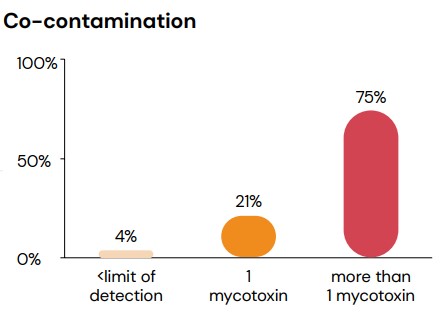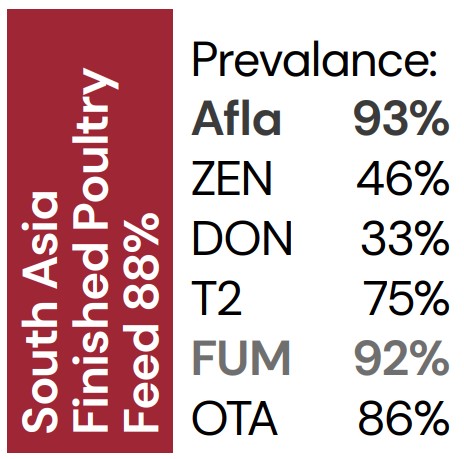 The dsm-firmenich mycotoxin survey stands as the longest running and most comprehensive data set concerning the prevalence of mycotoxins. Starting from 2004, this survey helps to understand the annual variations in mycotoxin occurrence across various regions in the world. The increasing sample size over the years provides in depth insights on the incidence of the six major mycotoxins, emerging and masked forms of mycotoxins in the agricultural commodities used for livestock feed and to identify the potential risks posed to livestock production.
The dsm-firmenich mycotoxin survey stands as the longest running and most comprehensive data set concerning the prevalence of mycotoxins. Starting from 2004, this survey helps to understand the annual variations in mycotoxin occurrence across various regions in the world. The increasing sample size over the years provides in depth insights on the incidence of the six major mycotoxins, emerging and masked forms of mycotoxins in the agricultural commodities used for livestock feed and to identify the potential risks posed to livestock production.
 The latest DSM-Firmenich world mycotoxin survey for the period of January to December 2023 consolidates data from over 113,500 analyses conducted on more than 23,800 samples worldwide. This comprehensive report offers insights into the prevalence of six major mycotoxins: aflatoxins (Afla), ochratoxin A (OTA), deoxynivalenol (DON), T-2 toxin (T-2), fumonisins (FUM), and zearalenone (ZEN). The survey results indicate that globally around 85% of the analysed samples are contaminated with mycotoxins, with 61% of samples showing co-contamination with multiple mycotoxins. Table 1 illustrates the mycotoxin prevalence and risk categorization across different regions globally.
The latest DSM-Firmenich world mycotoxin survey for the period of January to December 2023 consolidates data from over 113,500 analyses conducted on more than 23,800 samples worldwide. This comprehensive report offers insights into the prevalence of six major mycotoxins: aflatoxins (Afla), ochratoxin A (OTA), deoxynivalenol (DON), T-2 toxin (T-2), fumonisins (FUM), and zearalenone (ZEN). The survey results indicate that globally around 85% of the analysed samples are contaminated with mycotoxins, with 61% of samples showing co-contamination with multiple mycotoxins. Table 1 illustrates the mycotoxin prevalence and risk categorization across different regions globally.
Table 1: Mycotoxin prevalence and risk in different regions of the world in 2023
| Mycotoxin prevalence and risk category | % of samples above risk threshold | Region |
| Extreme | 76-100 | South Asia, China/Taiwan, North America, and Central America |
| High | 51-75 | South-East Asia, Central Asia, South Africa, Sub Saharan Africa, Southern Europe, and South America |
| Medium | 26-50 | Oceania, East Asia, Middle East & North Africa, Central Europe, Northern Europe, and Eastern Europe |
Mycotoxin prevalence and risk in South Asia:
In 2023, DSM-Firmenich conducted over 5200 mycotoxin analyses in South Asia. The most prevalent mycotoxins in South Asia are aflatoxins, fumonisins, T-2, ochratoxin, followed by zearalenone and deoxynivalenol. This region faces an extreme overall risk for mycotoxin prevalence, characterized by high concentrations of aflatoxins, fumonisins, and deoxynivalenol in the analyzed samples.
Of all the samples analyzed, 96% are contaminated with at least one mycotoxin, and 75% of samples contain multiple mycotoxins. The combination of multiple mycotoxins in feeds can result in more adverse effects than a single mycotoxin due to additive and synergistic interactions.
Soybean meal, rice bran, and DDGS are the most contaminated commodities in South Asia, with all the analyzed samples showing 100% contamination with one or more mycotoxins.
 In the analysis of corn samples, it was found that 95% are contaminated with mycotoxins. Fumonisins exhibit the highest prevalence at 76%, followed by aflatoxins (68%). The average contamination levels of FUM and Afla exceed tolerable limits significantly. Of particular concern is the average level of Afla in corn, which raises public health concerns for the dairy industry due to the necessity of maintaining aflatoxin M1 levels below specific regulatory thresholds.
In the analysis of corn samples, it was found that 95% are contaminated with mycotoxins. Fumonisins exhibit the highest prevalence at 76%, followed by aflatoxins (68%). The average contamination levels of FUM and Afla exceed tolerable limits significantly. Of particular concern is the average level of Afla in corn, which raises public health concerns for the dairy industry due to the necessity of maintaining aflatoxin M1 levels below specific regulatory thresholds.
Fumonisins disrupt the metabolism of sphingolipids, which are crucial components of cellular membranes and neural tubes. Fumonisin has synergistic effects with other mycotoxins like deoxynivalenol (DON), contributing to the disruption of the intestinal barrier, promoting the ‘leaky gut’ condition and as consequence high translocation of other toxic entities and pathogens, like Salmonella, Clostridium, E. coli and Campylobacter. Fumonisins can also induce cancers, immunosuppression, liver damage, and kidney damage. They are known as the most silent mycotoxins which robs the performance of the animals without showing pathognomonic signs.
Surprisingly, all soybean samples analyzed were contaminated with more than one mycotoxin. The prevalence of OTA is the highest at 96%, followed by Zen at 92% and T-2 at 91%. Although the contamination level of DON is low, its average concentration is remarkably high.
In rice grain samples, 94% were found to be contaminated. The highest prevalence is of T-2 at 83%, followed by Afla (61%), and OTA (44%). The average concentrations of Afla and OTA exceed the tolerable limits.
All the analyzed de-oiled rice bran samples exhibit mycotoxin contamination, with 94% of them being co-contaminated with multiple mycotoxins. ZEN shows the highest prevalence at 94%, followed by Afla (82%), T-2 (59%), and OTA (59%). The average concentrations of Afla, ZEN, and DON are relatively high.
DDGS is an extremely contaminated ingredient, 100% of the samples were found to be contaminated with multiple mycotoxins. Afla, T-2, and OTA contamination were prevalent in all samples, followed by Zen at 86%. The average concentrations of Afla, FUM, and OTA exceeded tolerable limits.
For Rapeseed meal, 94% of samples showed mycotoxin contamination. Aflatoxin was the most prevalent at 75%, followed by T-2 at 56%. However, the average positive rates for Afla and T-2 were low.
In corn silage samples, 88% were contaminated with at least 1 mycotoxin, with FUM being the most prevalent at 88%, followed by Afla and OTA. Although Afla contamination was lower, the average concentration was extremely high.
 In finished feed (poultry), 99% samples exhibited contamination with multiple mycotoxins, with Afla being the most prevalent at 93%, followed closely by FUM at 92%, OTA at 86%, and T-2 at 75%. The average concentrations of Afla, FUM, and DON are notably high, posing significant health and production challenges for poultry farming.
In finished feed (poultry), 99% samples exhibited contamination with multiple mycotoxins, with Afla being the most prevalent at 93%, followed closely by FUM at 92%, OTA at 86%, and T-2 at 75%. The average concentrations of Afla, FUM, and DON are notably high, posing significant health and production challenges for poultry farming.
Conclusion
The survey reveals an extreme risk associated with aflatoxins, T-2 toxin, ochratoxin, and fumonisins in South Asia. With the co-contamination levels being exceptionally high, there is a likelihood of experiencing more adverse effects attributable to mycotoxin synergism and additivity. Implementing thorough testing of raw materials and incorporating comprehensive broad-spectrum mycotoxin deactivators in the feed will mitigate the adverse effects of mycotoxins and improve the performance and profitability.
The full 2023 DSM World Mycotoxin survey report can be found here: https://www.dsm.com/anh/news/downloads/whitepapers-and-reports/dsm-firmenich-world-mycotoxin-survey-january-to-december-2023.html
For South Asia specific data, please contact your local dsm-firmenich representative.
- Dr Raju Jakkula, Ph.D.
Nutrition & Health Solutions Manager, South Asia
DSM-Firmenich, Animal Nutrition & Health
Mail: Raju.jakkula@dsm-firmenich.com
 Agrinews24 কৃষির সাথে, কৃষকের পাশে
Agrinews24 কৃষির সাথে, কৃষকের পাশে





















